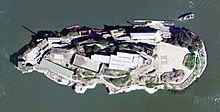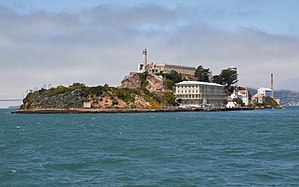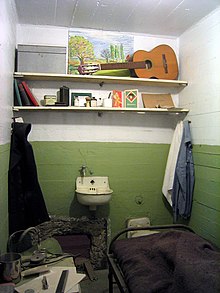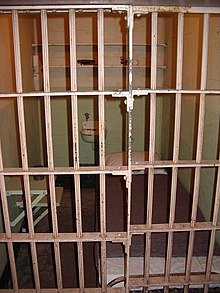Alcatraz
| Alcatraz | ||
|---|---|---|
| Alcatraz | ||
| Waters | San Francisco Bay | |
| Geographical location | 37 ° 49 '36 " N , 122 ° 25' 24" W | |
|
|
||
| length | 550 m | |
| width | 205 m | |
| surface | 8.5 ha | |
| Highest elevation | 41 m | |
| Residents | uninhabited | |
| Alcatraz seen from the east | ||
Alcatraz is a 8.5- acre , 500-meter-long and up to 41- meter- high American rock island in the Bay of San Francisco , California , around 2 km from the mainland.
The first lighthouse on the US west coast went into operation on the island in 1854 . In the second half of the 19th century it was used as a site for a fortified fort . A prison was integrated into it as early as 1861 , initially for Confederate prisoners of war during the Civil War . In the early 1930s, the fort was converted into a prison island and from 1934 to 1963 functioned as one of the most famous and notorious high-security prisons in the USA at the time.
The prison was abandoned in 1963 due to excessive operating costs. In 1964 and from the end of 1969 to mid-1971, Alcatraz Island, which had been considered uninhabited by the authorities since the prison was closed, attracted renewed public attention due to politically motivated occupation actions by the Indian movement .
The island is now used as a museum tourist attraction. As part of the Golden Gate National Recreation Area , Alcatraz is under the supervision of the US National Park Service .
history
Discovery and naming
The Spanish explorer Juan Manuel de Ayala sailed into the Bay of San Francisco in 1775 and gave Spanish names to the sandstone islands he found there. Originally he called ("because of the abundance of birds on this island") with Isla de Alcatraces what is now called Yerba Buena Island . The name was transferred to today's Alcatraz in 1826 by the British naval captain and geographer Frederick William Beechey in the form of Alcatrazes Island . The island was finally named Alcatraz Island in 1851 by the American Coast Guard after California became a US state in 1850 after the Mexican-American War .
The exact meaning of Alcatraces in de Ayala's name is somewhat controversial, but the translation pelicans is usually chosen. Alcatraces in today's Spanish stands for boobies and not for pelicans , but the Arabic alcatraz , which has been attested in Spanish since at least 1386 , was also used in the past to mean a kind of pelican .
Expansion to a fort and prison

In 1846, John Charles Fremont , California's military governor, bought the then Mexican Alcatraz from its previous owner, Francis Temple, for the United States for $ 5,000. After the end of the Mexican-American War , however, both Temple and Fremont registered ownership rights. This was not recognized by the United States, as Julian Workman, Francis Temple's father-in-law and previous owner of Alcatraz, had failed to fulfill his part of the contract to build a lighthouse on the island and Fremont was not in the position anyway Island to buy on behalf of the United States. Thus all contracts were void. The island fell to the United States and has remained in the possession of the federal government to this day.
As a result of the high number of ships, triggered by the gold rush in California in 1848, and the loss of many ships due to insufficient visibility and the heavy fog formation, a lighthouse was finally built on Alcatraz in 1852. This was the first lighthouse in the entire American Pacific area. The lens for the light did not arrive in San Francisco from France until 1853, and it took another year to find someone who could fit it. The lighthouse was not put into operation until June 1, 1854.
After that, military use began with the construction of Fort Alcatraz from 1853 to 1859, which was used as a prison for prisoners of war for the first time from 1861. A group of Confederate soldiers and the crew of a Confederate merchant ship were interned here during the American Civil War . The dungeon of a brick building served as the cells. In 1903, however, the prison was so dilapidated that it had to be closed. The plans for a new building began in 1906, but were thrown back by the severe earthquake in the same year. The construction of the new prison lasted from 1906 to 1911. Now a reinforced concrete building was used as a cell wing, which can still be visited today. In 1909 the lighthouse was rebuilt. The fort was abandoned in 1933.
Maximum security prison
On October 12, 1933, the conversion into a correctional facility finally began, and on January 1, 1934, Alcatraz was converted into a federal prison . Because of the cold water in the bay and the treacherous current, "The Rock" was ideally located for a prison, as escape seemed impossible. The first prisoners, 53 inmates from the Atlanta State Prison , arrived in 1934. Alcatraz functioned as a maximum security prison until 1963, housing prisoners who were found to be incorrigible and difficult in other prisons. Among them were well-known gangsters such as Al Capone (1934–1939), Robert Franklin Stroud (1942–1959), Machine Gun Kelly (1934–1951), Alvin "Creepy" Karpis (1936–1962) and the German spy Erich Gimpel (1945-1955).
Over the next 29 years of use, the island detained some of the most notorious criminals in the United States. A total of 1,576 prisoners were imprisoned on Alcatraz, never more than 302 of them at the same time. The prison guards lived on the island with their families; a total of around 300 civilians, including 80 children.
The cells were 1.52 x 2.74 meters, with a sink, toilet and bed. The prisoners stayed here between 18 and 23 hours a day, everything else was special concessions that were only granted with good guidance. Participation in the work program was also a special benefit. Here were road signs made. Tear gas containers were attached to the ceiling of the dining room for emergencies , but they never had to or could never be used, as many prison guards were in the dining room during mealtime and they would have harmed themselves or could not have intervened. The prison was also the only one in the country to have hot water showers. Only warm water in the shower facilities was intended to prevent the inmates from getting used to cold water when attempting to escape.
Attempts to escape
Even when it was a military prison, there were at least 29 escape attempts with a total of 80 people involved. 62 of them were captured, one is likely to have drowned, the fate of the other 17 is unclear.
In its 29 years as a maximum security prison, there were 14 escape attempts by a total of 34 prisoners (including Joseph Paul Cretzer and Sam Shockley, who participated in two attempts), but no known successful escape. 25 fugitives were caught alive (Shockley, who was caught twice, and one other prisoner were later executed in the gas chamber ), six were shot while trying to escape (including Cretzer in the " Battle of Alcatraz "), five fugitives have disappeared to this day and probably in the cold Sea drowned. The story that the waters around the island were frequented by man-eating sharks was only spread as a deterrent. The only sharks off Alcatraz were harmless cat sharks .
In May 1946, three inmates and two prison guards were killed in the " Battle of Alcatraz ". Six convicts had taken several guards hostage in order to escape with their transport ship. After several days of negotiations, the marines alerted to support the police overwhelmed the insurgents using hand grenades and firearms.
On June 11, 1962, inmates Frank Morris and the two brothers John and Clarence Anglin disappeared from their cells, a fourth man had to be left behind due to lack of time. The three men were able to dig their way through the ventilation grids of the cells, as the mortar, which had been badly attacked by salt and moisture, had become brittle and could therefore be easily scraped away with solid steel cutlery smuggled into the cells. They finally got outside through the ventilation shaft and the roof of the cell block and then disappeared in a rubber dinghy they had made themselves with the help of raincoats and glue. Their disappearance wasn't noticed until the next morning, when they were already over nine hours ahead. Parts of her inflatable boat and her swimming aids were washed ashore or salvaged by fishermen. The FBI investigation into the case, completed in 1979, suspects the fugitive's death by drowning. The bodies were never found, which is not unusual for the bay with its strong current out to the open Pacific. Nevertheless, rumors of a successful escape persist. The story was later used as a template for the movie Escape from Alcatraz starring Clint Eastwood . In 2013 the San Francisco Police Department received a letter allegedly written by John Anglin. In this he writes about the successful escape of all three escapees. Clarence Anglin died in 2008 and Frank Morris died in 2005, John Anglin himself suffered from cancer. An analysis of the handwriting by the FBI could not clearly clarify whether the letter is authentic. In 2015, a photograph from the family's surroundings appeared that allegedly shows the two Anglin brothers on a farm in Brazil in 1975. The analysis of the picture a few years later with the help of face recognition methods supports the claim that the men depicted are the brothers.
Another escape took place in December 1962. The bank robber John Paul Scott swam through the cold water for over an hour with the help of inflated rubber gloves. He was found half frozen on the mainland, had to be resuscitated and was then brought back to the island. The reputation as an escape-proof prison was thus shaken again. The costs of the institution - even the drinking water had to be brought to the island by ship - and the building structure, which was badly damaged by the salt corrosion, ultimately caused The Rock to be closed .
An attempt by the TV series Mythbusters also shows that, contrary to what was assumed at the time, an escape from Alcatraz was theoretically possible. The simulated escape used the idea of a rubber dinghy made of raincoats and actually landed three people at the Marin Headlands north of the Golden Gate Bridge . The program Galileo also tried to recreate the escape in the series "Galileo extreme". A reporter swam the distance to the mainland unaided in 37 minutes. It is questionable whether prisoners would have managed that, as they were often in poor physical condition and not used to cold water.
On the occasion of his TV special Escape from Alcatraz in 1987, David Copperfield was locked in a cell and astonished a group of viewers with his tricks.
Bad planning during construction
The escape attempts are to a very large extent due to poor planning and cost savings.
The slowly but steadily rotting walls, for example, can be traced back to the fact that the cell toilets were not operated with fresh water, but with salt water pumped from the bay. As a result, the supply and discharge pipes to the toilets corroded heavily over the years and thus became leaky. Due to the constant contact of the cell walls with salty water, the steel reinforcement inside the concrete gradually rusted. Together with the influence of the salty air, this led to a weakening of the reinforcement and the cracking of the concrete. Furthermore, the mistake was made of not providing the cell doors on cell block D with round and hardened steel, as with the other blocks, but with flat iron, which can be easily cut with a hacksaw blade, due to lack of money.

Closure of the prison
In early 1963 , Justice Minister Robert F. Kennedy ordered the prison to be closed because of the high operating costs and the increasing deterioration of the system from the salt water, which made constant maintenance of the old walls necessary . This took place on March 21, 1963 with the transfer of the last prisoners. The island has been uninhabited since then.
Occupation by Indians
On November 8, 1969, about 40 Sioux Indians occupied the island to demonstrate for the implementation of the Fort Laramie Treaty , which had promised the Indians the use of former federal territory if it were no longer needed. They offered to take over the island for 47 cents an acre . This was the price California offered to Indians at the time in return for unlawful land grabbing in the previous century.
On November 9, 1969, the Indians of All Tribes ( English Indians of all tribes ), a group of young Indians, left their ironic offer to buy the island for "24 dollars in glass beads and red cloth" before a largely unsuccessful occupation attempt. From November 20, 1969, they actually occupied Alcatraz with almost 80 people from 20 tribes. In the months that followed, there was a lot of press coverage and some influx of people who came to Alcatraz for support for a few days or months. There was moral and material support, among other things. by the musicians of the rock band Creedence Clearwater Revival . In the early summer of 1971, the US government decided to evacuate the island by force. The timing seemed right because, according to reports, only 11 to 15 Indians stayed on the island at the time, but would probably get new students when the holidays started. Government officials also alleged that there was a long time between now and the next election, so even if there were unsightly scenes, the public would forget about the matter. On June 11, 1971, the US Coast Guard sealed off the island, and about 30 FBI agents brought the remaining Indian activists to the mainland without encountering any resistance.
Some squatters, including John Trudell and Dennis Banks , were also involved in the founding of the American Indian Movement (AIM) in the late 1960s . In the 1970s you became the spokesman for this indigenous resistance organization, which is best known today, to enforce specifically Indian self-determination interests against the official Indian policy of the United States .
Since 2011 there has been a permanent exhibition on the occupation in the American Indian cultural center of the former prison, which archives documents and film recordings from the occupation period.
Opening up to the public
After that there were attempts to convert Alcatraz into a casino ; however, no investor was found. The island was finally opened to the public in 1972 as part of the newly created Golden Gate National Recreation Area .
Today Alcatraz is a tourist attraction with over a million visitors a year. The cell block, the dining room, the library and the prison yard can be visited. In addition, a small prison exhibition can be viewed in the guards' former accommodation block. You are guided through the actual cell block with the help of audio playback devices in various languages (including German). In the English version, you can hear original recordings of contemporary witnesses who report on their experiences in prison.
Alcatraz was added to the National Register of Historic Places as a Historic District on June 23, 1976 . The island has been a National Historic Landmark since January 17, 1986 .
The island is a nesting place for pigeon ducks , western and California gulls , black and white herons , shags and shags and other bird species. Scientific support is provided as part of the Alcatraz Waterbird program . To protect the birds, certain areas are closed to visitors from February to September.
Imprisonment
On average, there were no more than 250 inmates in the prison at any one time. The prisoners' average residence time was ten years. They were only allowed an hour's visit once a month. If the rules were violated, the inmates were taken into solitary confinement. They had to spend 18 days in a solitary cell, either every night with constant lighting or every day in the dark.
Alcatraz had two roles:
- Taking over troublemakers from other prisons to prevent escape, violence and suicide attempts.
- Taking over prisoners in order to send them back to another prison better. There was never any talk of rehabilitation .
panorama
Adaptations in film and television
- In Birdman of Alcatraz (Birdman of Alcatraz) of 1962 provides Burt Lancaster by a true story of a prisoner in solitary confinement is, the self-taught a recognized ornithologist is.
- In Point Blank (USA 1967), directed by John Boorman , with Lee Marvin and Angie Dickinson , the prison is the scene of the showdown . This was the first feature film to be shot on the island after the federal prison was closed in 1963.
- In Dirty Harry III - The Enforcer , (The Enforcer) from 1976 to hide terrorists in Alcatraz, and inspector (Dirty) Harry Callahan ( Clint Eastwood ) gets to render them harmless the job.
- In Escape from Alcatraz (Escape From Alcatraz) of the 1979 Clint Eastwood is seen in the role of Frank Morris, the 1962 outbreak succeeded (he and his accomplices but possibly drowned in the San Francisco Bay).
- In On the Edge of Hell (Six against the Rock) with David Carradine from 1987, the prison revolt of 1946 is described.
- Murder in the First (USA 1995) with Kevin Bacon , Christian Slater and Gary Oldman is based on a true case: In 1938 a petty thief in Alcatraz ends up in a dark cell for three years. The subsequent process leads to the abolition of solitary confinement in 1943.
- The Rock , a 1996 action film, uses Prison Island as a backdrop. The main roles are played by Sean Connery and Nicolas Cage .
- In X-Men: The Last Resistance , a fictional research laboratory is located on the island, which is fought over in the showdown.
- Alcatraz is an American mystery series with science fiction elements, which was produced from 2011 to 2012 by Warner Bros. Television and Bad Robot Productions for the US broadcaster Fox. It is about a 50-year-old incident on the prison island of Alcatraz, in which a group of convicts and guards disappeared without a trace and now reappears in the present.
- In the horror film Slaughterhouse - A Horror Trip into the Beyond by director Dimitri Logothetis from 1988, the prison island is a central location of the plot.
- In The Book of Eli - the last fighter (The Book of Eli) from the year 2010, the prison island is presented as a haven where people gather lost knowledge in order to begin rebuilding.
literature
- John Arturo Martini: Fortress Alcatraz - Guardian of the Golden Gate. Ten Speed Press, Berkeley CA 2004, ISBN 1-58008-626-8 .
- Ingo Becker-Kavan: Alcatraz - A synonym for deterrence. Verlag Königshausen & Neumann, Würzburg 1998, ISBN 3-8260-1415-4 .
- Adam Fortunate Eagle: Alcatraz! Alcatraz! The Indian occupation of 1969-1971 (California Indian Series) , Heyday Books 1992, ISBN 0-930588-51-7 .
Web links
- National Park Service: Alcatraz (official site; English)
- Detailed virtual tour of Alcatraz, from the dock to the cellhouse including audio tour (German)
- Extensive documentation of Alcatraz with numerous photos (English)
Individual evidence
- ↑ California Place Names: The Origin and Etymology of Current Geographical Names (Third Edition), Erwin Gustav Gudde, University of California Press, Berkeley and Los Angeles, 1969, p. 6.
- ^ Gregory L. Wellman: A History of Alcatraz Island: 1853-2008 , Arcadia Publishing, Charleston SC, Chicago IL, Portsmouth NH, San Francisco CA, 2008, pp. 7 and 8 (English).
- ↑ A Brief History of Alcatraz on the Federal Bureau of Prisons website .
- ↑ Alcatraz at www.aviewoncities.com (English).
- ↑ Alcatraz (e) , information on the origin of the French word in the etymological online lexicon of the Center National de Ressources Textuelles et Lexicales (French).
- ↑ a b Escapes from Alcatraz , page on www.sfgenalogy.com; see also the list of names with quotations from newspaper reports at the time (both in English).
- ↑ Alcatraz Escape Attempts. In: alcatrazhistory.com , (English).
- ↑ The Rock - Alcatraz Island Prison. Broadcast in N24 , September 19, 2009.
- ↑ Escape utensils of the fugitives around Frank Morris. FBI , June 12, 2012, accessed December 27, 2014 .
- ^ Robert D. McFadden: Tale of 3 Inmates Who Vanished From Alcatraz Maintains Intrigue 50 Years Later , New York Times , June 9, 2012.
- ↑ Alcatraz escape: Fugitive John Anglin's name on letter to police. Retrieved March 21, 2018 .
- ↑ Amy B. Wang: A man claims three Alcatraz prisoners 'barely' survived a 1962 escape - and that he's one of them. In: The Washington Post . January 24, 2018, accessed on May 30, 2019 (English, paid access).
- ↑ https://www.dailymail.co.uk/news/article-3270269/The-picture-proves-two-inmates-DID-escape-Alcatraz-Notorious-escapees-didn-t-drown-body-surfed-iegenger -ferry-freedom-started-farm-Brazil-claims-family.html , accessed on February 2, 2020 (English)
- ↑ Alcatraz escape mystery may have just been solved with facial-recognition tech on campaignlive.co.uk
- ↑ Artificial intelligence solves a 57-year-old Alcatraz outbreak on it-boltwise.de
- ↑ https://www.alcatrazcruises.com/de/history-of-alcatraz/federal-penitentiary/ , accessed on February 2, 2020.
- ↑ Ben Winton: The occupation of Alcatraz. ( Memento from May 23, 2008 in the Internet Archive ) In: thenativepress.com , November 15, 2007 (English).
- ↑ Jay Barmann: American Indian Occupation Gets Permanent Exhibit At Alcatraz. ( Memento from May 16, 2016 in the Internet Archive ) In: sfist.com , November 21, 2011 (English).
- ↑ Entry in the National Register Information System . National Park Service , accessed May 20, 2016.
- ↑ Listing of National Historic Landmarks by State: California. National Park Service , accessed July 23, 2019.
- ↑ a b Waterbirds of Alcatraz , National Park Service information brochure for visitors to the Golden Gate National Recreation Area . P. 2 (English).
- ↑ Alcatraz Waterbird Intern ( Memento from November 29, 2014 in the Internet Archive ) ( MS Word ; 666 kB). Job advertisement for 2014 (English).







